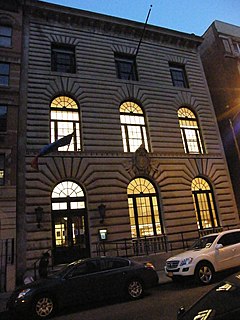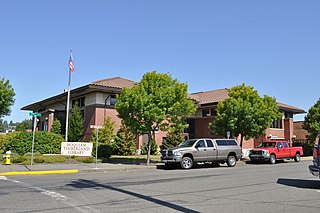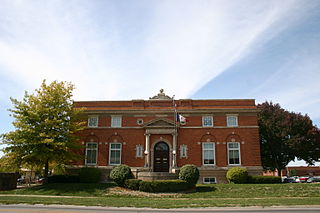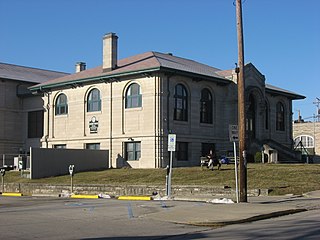Joplin Public Library District is the library services for Joplin, Missouri.

The Jennings Carnegie Public Library is a Carnegie library located at 303 North Cary Avenue in Jennings, Louisiana.

The Niagara Falls Public Library, located at 1425 Main Street, in Niagara Falls in Niagara County, New York. The Main Library is the largest library in the Niagara-Orleans-Genesee Library System. The Main Library in the Earl W. Brydges Building, was built in 1974 by Paul Rudolph, and the LaSalle Branch is located at 8728 Buffalo Avenue in the LaSalle District of Niagara Falls.

The Joplin Carnegie Library is a historic Carnegie library located at Joplin, Jasper County, Missouri. It was built in 1902, and is a two-story, Classical Revival style steel frame building sheathed in brick and white Carthage marble. It measures 79 feet by 86 feet and features a pedimented Ionic order porch which is distyle in antis. A four-bay two story addition was added in 1916. Andrew Carnegie provided $40,000 for its construction.

The Harry Belafonte 115th Street Branch of the New York Public Library is a historic library building located in Harlem, New York City. It was designed by McKim, Mead & White and built in 1907–1908 and opened on November 6, 1908. It is a three-story-high, three-bay-wide building faced in deeply rusticated gray limestone in a Neo Italian Renaissance style. The branch was one of 65 built by the New York Public Library with funds provided by the philanthropist Andrew Carnegie, 11 of them designed by McKim, Mead & White. The building is 50 feet wide and features three evenly spaced arched openings on the first floor. The branch served as Harlem cultural center and hub of organizing efforts.

The Johnstown Flood Museum is a history museum located in Johnstown, Pennsylvania, dedicated to the Johnstown Flood of 1889. The museum is housed in the former Cambria Public Library, which is part of the Downtown Johnstown Historic District.

The Auburn Public Library is a former library building located in Auburn, Washington listed on the National Register of Historic Places. The Auburn Carnegie library is a rectangular 2-story brick building with a cast concrete foundation. It has a hip roof with a slight flare at the projecting eaves. The roof is composition tile. The building measures 35 by 50 feet, and there is a 4 by 10 feet extension at the center of the west facade. The extension projects above the eaves. The gable is highlighted with a parapet trimmed with pressed metal. A 12 feet (3.7 m) cast stone entrance arch with two panel doors in the face of the extension forms the main entry. Fenestration consists of long casement windows in front and smaller ones on the sides and in back. Above each is a small fixed window divided by muntins into eight triangular panes.

The Carnegie Library in Newton, Kansas is a building from 1903. It was listed on the National Register of Historic Places in 1974.

The Carnegie Library is a historic building still in use as the Hoquiam Timberland Library in Hoquiam, Washington.

The Hollister Carnegie Library is located on 375 Fifth Street in Hollister, California, US. Established in 1912 as a Carnegie library, decades later, it was re-purposed as a city hall. The building is part of the downtown's National Register-listed historic district, and was entered itself into the National Register on March 26, 1992.

The Fletcher Free Library is the public library serving Burlington, Vermont. It is located at 235 College Street, in an architecturally distinguished Beaux-Arts building, constructed in 1902 with funding support from philanthropist Andrew Carnegie. The building was listed on the National Register of Historic Places in 1976.

The Carnegie Library of Albany is a Carnegie library in Albany, Missouri, listed on the National Register of Historic Places. It was designed by Edmond J. Eckel and opened in 1906.

Goshen Carnegie Public Library, also known as the Goshen Public Library, is a historic Carnegie library located at Goshen, Elkhart County, Indiana. It was built in 1901, and is a 1+1⁄2-story, Beaux-Arts style building clad in Bedford limestone. It has a red tile roof and projecting entrance pavilion with two Tuscan order columns. Its construction was funded with $25,000 provided by the Carnegie Foundation.

Oskaloosa Public Library is a facility located in Oskaloosa, Iowa, United States. Construction of the library was launched in 1902 with a grant from the Carnegie Corporation of New York. The building was added to the National Register of Historic Places in 1991.

Monroe Carnegie Library, also known as Old Monroe Carnegie Library, is a historic Carnegie library located at Bloomington, Monroe County, Indiana. It was built in 1917, and is a one-story, rectangular, Neoclassical style limestone building on a raised basement. The Monroe County History Center is a history museum the historic library building that was established as a Carnegie library. The museum is located on the site of Center School in the former Bloomington Public Library building. The library building is now home to the Monroe County Historical Society, their collection of artifacts, and their Genealogy Library. A historical marker is present at the site. The History Center is located at 202 East 6th Street. It is a tourist attraction.

St. Joseph Public Library-Carnegie Branch is a historic Carnegie Library building located at St. Joseph, Missouri. It was designed by the architect Edmond Jacques Eckel (1845–1934) and built in 1902 in the Classical Revival style. It is a one-story, brick and limestone building over a raised basement. It features a projecting front portico with four fluted Ionic order limestone columns. It was built with a $50,000 grant from the Carnegie Foundation.

Sedalia Public Library is a historic Carnegie library building located at Sedalia, Pettis County, Missouri. It was designed by the architecture firm Shepley, Rutan and Coolidge and built in 1900. It is a two-story, cruciform plan, Greek Revival style wood and steel frame building with brick walls and limestone and terra cotta facing. It is seven bays wide with an open tetrastyle Ionic order portico on the front facade. It was the first public library in the state of Missouri to receive a Carnegie grant for construction of a library building. The grant was $50,000.

Bolivar Public Library, also known as the Carnegie Library of Bolivar and Polk County Genealogical Society Library, is a historic Carnegie library located at Bolivar, Polk County, Missouri. It was built in 1915, and is a 1 1/2- to two-story, rectangular, brick building with Classical Revival style design elements. It has a flat roof and three bay front facade with an elaborate center entranceway and large side window bays. It features intact terra cotta and tooled limestone ornamentation. It was funded by an $8,000 Carnegie grant from the Carnegie Foundation. The property was listed on the National Register of Historic Places in 2003.

The Osborne Public Carnegie Library is a historic Carnegie library in Osborne, Kansas. It was built around 1913 and was listed on the National Register of Historic Places in 1987.






















